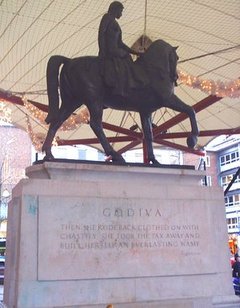Godiva
|
|
- This article refers to Lady Godiva. Godiva can also refer to a Belgian chocolate-maker, and to the Godiva programming language.
Lady_Godiva_contrast_enhanced.jpg
Godiva (sometimes Godgifu) (c. 980 – 1067) was an Anglo-Saxon lady, who, according to legend, rode naked through the streets of Coventry in England, in order to gain from her husband a remission of the oppressive toll imposed on his tenants.
| Contents |
Legend
The story is that she was the beautiful wife of Leofric III (968 – 1057), Earl of Mercia and lord of Coventry. The people of that city were suffering grievously under the earl's oppressive taxation. Lady Godiva appealed again and again to her husband, who obstinately refused to remit the tolls. At last, weary of her entreaties, he said he would grant her request if she would ride naked through the streets of the town. Lady Godiva took him at his word, and after issuing a proclamation that all persons should keep within doors or shut their windows, she rode through, clothed only in her long hair. One person disobeyed her proclamation, a tailor, ever afterwards known as Peeping Tom. He bored a hole in his shutters that he might see Godiva pass, and is said to have been struck blind. Her husband kept his word and abolished the onerous taxes.
The oldest form of the legend has Godiva passing through Coventry market from one end to the other while the people were assembled, attended only by two female (clothed) riders. This version is given in Flores Historiarum by Roger of Wendover (died 1236), a somewhat credulous collector of anecdotes, who quoted from an earlier writer. The still later story, with its episode of Peeping Tom, appeared first among 17th century chroniclers. Whether the Lady Godiva of this story is the Godiva or Godgifu ("gift of God") of history is undecided.

The claim that Godiva's long hair effectively hid her from sight is generally believed, like the story of Peeping Tom, to have been a later addition, but compare Rapunzel. Certain other thematic elements are familiar in myth and fable: the resistant Lord (Esther and Ahasuerus), the exacted promise, the stringent condition, the test of chastity. Even if Peeping Tom is a late addition, his being struck blind demonstrates the closely knit themes of the violated Mystery and the punished intruder (compare Diana and Actaeon).
It is also thought that Lady Godiva's "nakedness" refers to her riding through the streets without wearing any jewelry, which was a trademark of her upperclass rank.
Nevertheless, that a lady of this name existed in the early part of the 11th century is certain, as evidenced by several ancient documents, such as the Stow charter, the Spalding charter, and the Domesday survey, though the spelling of the name varies considerably. It would appear from the chronicles of Ely, Liber Eliensis (end of 12th century), that she was a widow when Leofric married her in 1040. In or about that year she aided in the founding of a monastery at Stow, Lincolnshire. In 1043 she persuaded her husband to build and endow a Benedictine monastery at Coventry. Her mark, "di Ego Godiva Comitissa diu istud desideravi", was found on the charter given by her brother, Thorold of Bucknall, sheriff of Lincolnshire, to the Benedictine monastery of Spalding; and she is commemorated as benefactress of other monasteries at Leominster, Chester, Wenlock, Worcester, and Evesham. She is mentioned in the Domesday survey of 1085, as one of the few Anglo-Saxons to retain land after the conquest, and the only woman mentioned as a landholder. She probably died a few years later and was buried in one of the porches of the abbey church. Dugdale (1656) says that a window, with representations of Leofric and Godiva, was placed in Trinity Church, Coventry, about the time of Richard II.
The Godiva procession—a commemoration of the legendary ride instituted on May 31, 1678, as part of Coventry fair—was celebrated at intervals until 1826. From 1848 to 1887 it was revived, and continued into the 21st century.
The wooden effigy of Peeping Tom which, since 1812, has looked out on the world from a house at the northwest corner of Hertford Street, Coventry, represents a man in armour, and was probably an image of Saint George. It was removed from another part of the town to its present position.
Engineering and Lady Godiva
In many University Engineering faculties, military Engineering Corps and other Engineering organizations, Lady Godiva is considered to be the patron saint of engineers.
Historically, many organizations staged an annual "Godiva Ride" where a naked female rides a horse across campus. This practice was eventually stopped due to its offensiveness towards women, spurned by such unfortunate events as the École Polytechnique Massacre at l'École Polytechnique de Montréal.
Many engineers' rallying songs make reference to Lady Godiva (See Godiva's Hymn).
Music and Lady Godiva
Several popular songs make contemparary usage of the Lady Godiva image. These include The Velvet Underground's "Lady Godiva's Operation" off their 1968 LP White Light/White Heat, Peter and Gordon's "Lady Godiva" (1967), and a reference in Queen's "Don't Stop Me Now" (1978):
"I'm a shooting star leaping through the skies
Like a tiger defying the laws of gravity
I'm a racing car passing by like Lady Godiva
I'm gonna go go go
There's no stopping me"
See also
- Asteroid 3018 Godiva, named after Lady Godiva.
- Godiva Chocolates, a Chocolate Company named after and featuring artwork of Godiva on their boxes
- Godiva's Hymn, a traditional Engineering song
External links
- Cecilia Parsons, "Countess Godiva", 1999 (http://www.btinternet.com/~parsonal/godiva.htm): biography and developing legend
- BBC News (http://news.bbc.co.uk/1/hi/in_depth/uk/2000/newsmakers/1507606.stm) – the unearthing of a stained glass window identified with Lady Godivade:Godiva
